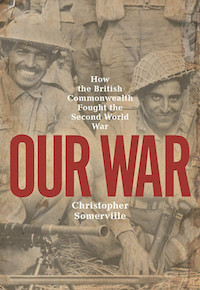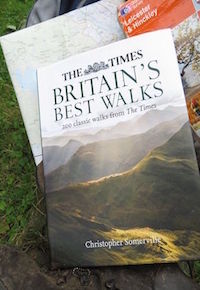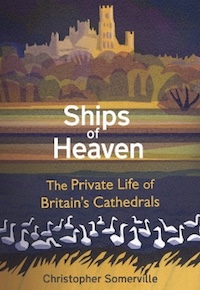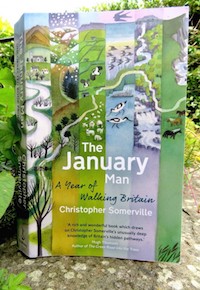About the Author
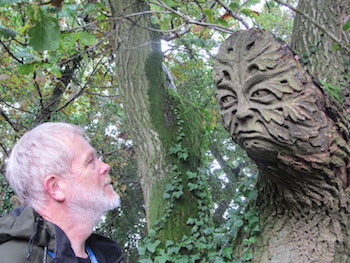
About Christopher
Christopher Somerville is Walking Correspondent of The Times. His long-running ‘A Good Walk’ series appears every Saturday in the Times Weekend section. He has written some 40 books, many about his travels on foot in various parts of the world, and thousands of articles in all the national newspapers. He has had two collections of poetry published. He loves music, and sometimes tries to play it.
Walking the Bones of Britain
(published by Doubleday, 24 August 2023)
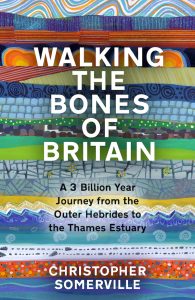
Walking the Bones of Britain is the story of a thousand-mile journey through the rocks and landscapes of the British Isles, unrolling over three billion years. It starts in the Outer Hebrides at the northwest tip of Scotland among the most ancient rocks in the land, formed in fire and fury when the world was still molten. And it finishes a thousand miles away in the southeast corner of England, where nature and man are collaborating to build new land.
In between, an incredible journey along footpaths and byways, moving from melted rock to volcanic upheaval, the clash of continents, mountain ranges rising and falling, seas invading and retreating, lands ripped apart and oceans snapping shut. In the evidence of the rocks under our feet and the landscapes around us we find life forming and flourishing, snuffed out by crashing asteroids, sent packing by ice sheets a mile thick, flooding back by land and sea.
And man as survivor and inventor, destroyer and conserver, rushing to the cliff edge and drawing back, time after time.
This book has taken me forty years to realise. It brings together two national treasures particular to the UK – this country’s unrivalled network of public footpaths, and the unique diversity of the geology that shapes its landscapes and history.
Geology can be very hard work. I have written Walking the Bones of Britain to demystify the subject, and to unearth from its dry, stony vocabulary and dense layers of facts the really vivid and extraordinary events that give these islands the world’s richest and most remarkable geological story.
Chapter 17. Wallasea Island, Essex (extract)
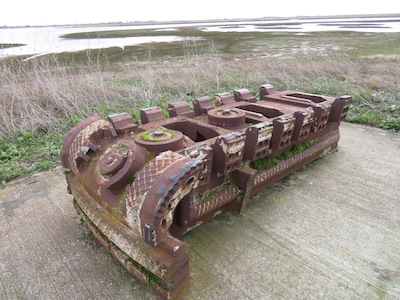
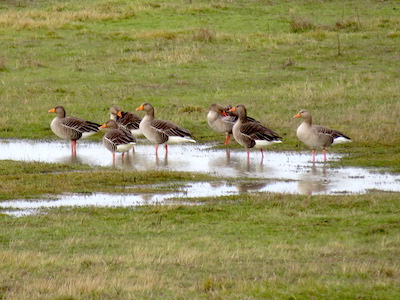
(a) Cutting head of Crossrail tunnel boring machine (b) Greylag geese on Wallasea’s new grazing marshes
When I first ventured to Wallasea Island in the 1980s, it was a dead flat, dead green crop factory in a remote corner of the Essex coast. The one public footpath petered out halfway round the crumbling sea wall of the island, and there was no particular welcome for wildlife or the walker. Then lonely Wallasea was chosen by DEFRA, the Department for Environment, Food & Rural Affairs, for the innovative experiment of ‘managed realignment’ – in other words, breaking the walls to let in the sea, an attempt to work with natural forces rather than continue with the futile policy of trying to outface them. Between 2007 and 2015 Wallasea saw the arrival of three million tons of ‘arisings’ or spoil, excavated during the building of tunnels and ventilation shafts for the Crossrail rapid transit railway across London. The spoil was loaded into dumper trucks and carted off to form the islets, banks and foundations of Jubilee Marsh, and to reinvent the cornfields as saline lagoons with their own creeks and grazing marshes.
Looking from the new sea wall today, I really could not believe it was the same place. Where were the wall-to-wall fields of corn and beans? Staring south across the island, I saw the whole regimented prairie had gone. In its place lay pools and lagoons, coarse grasslands and marshes, as far as I could see. And on this bitter winter day the island was alive with the movements and noises of birds. Curlews bubbled, oystercatchers piped, pik-pik! Redshank and shelduck patrolled the shore. Brent geese with white rumps and black heads came in to land on the grass with hoarse hound-like yelping, their wings held stiffly up and behind them at the moment of landing.
… Over on Foulness Island someone had lit a monstrous fire. Black smoke rose from a red glowing point and billowed into the sky. 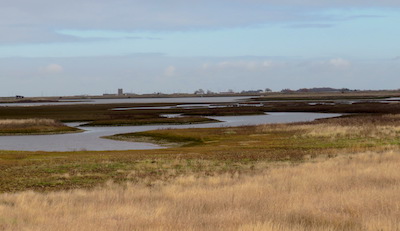 The volcanic look of the fire sent me back through the bones of Britain, back up the long road past the glittering city and the gently settling chalk, the Great Dying and the miracle of life on land and in the sea, past gritstone and limestone, coal and shale and the metamorphic mountains, all the way back to the fire and fury at the beginning of the world. There was a tingle in my feet and my head seemed full to bursting. What a hell of a journey I’d been on.
The volcanic look of the fire sent me back through the bones of Britain, back up the long road past the glittering city and the gently settling chalk, the Great Dying and the miracle of life on land and in the sea, past gritstone and limestone, coal and shale and the metamorphic mountains, all the way back to the fire and fury at the beginning of the world. There was a tingle in my feet and my head seemed full to bursting. What a hell of a journey I’d been on.
(c) Jubilee Marsh, Wallasea – created in 2015
- ‘Vivid reading. Knowing that some of the fighting in the Burmese jungle was hand-to-hand is one thing; reading what it was like to take part in a bayonet charge is quite another.’ – Sunday Telegraph
- ‘Perfect for veteran ramblers and leisurely strollers alike.’ – Coast Magazine
- ‘Cathedrals are all things to all people. … To capture all this, vividly and stylishly, in one book suggests something close to divine inspiration … Yet it’s not the breadth of his travels that impresses. It’s the depth of the “cathedral experience” that he uncovers by the old-fashioned journalistic method of getting knowledgeable people to talk freely about what they know best, then using his sharp eyes and wits to fill in the rest of the story.’ – Richard Morrison, The Times
- ‘This is nature at its most embracing; human nature richly-woven into the cycle of the seasons and the ecologies of father and son, observed with the passion and learning of Britain’s favourite walker. A truly wonderful, uplifting book, bursting with life.’ Nicholas Crane
